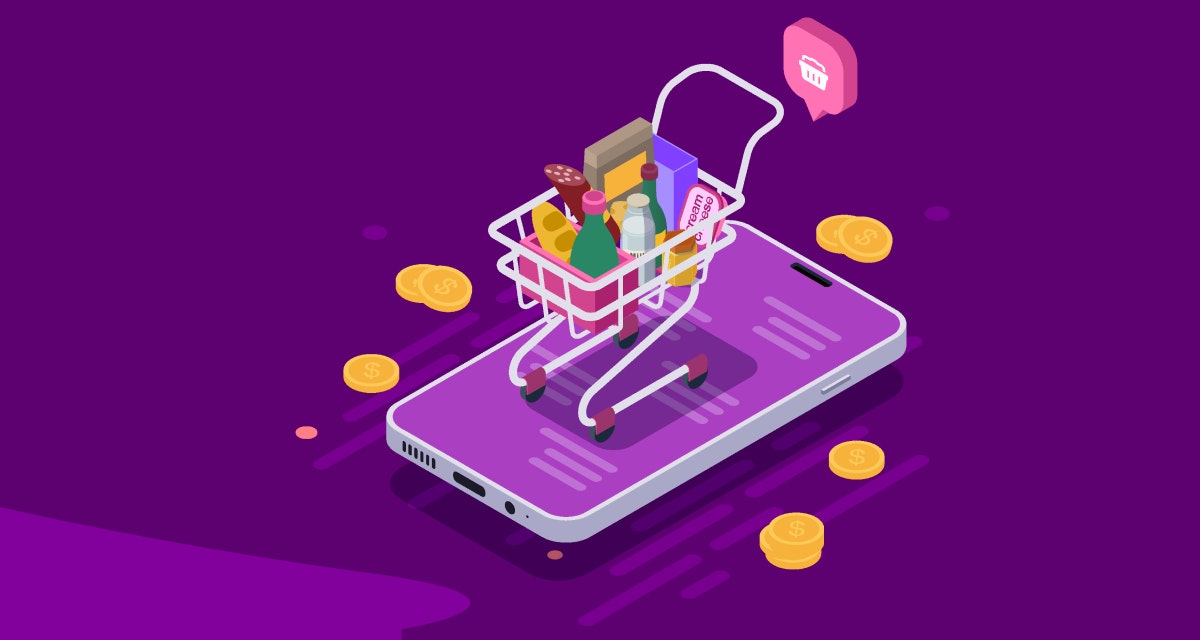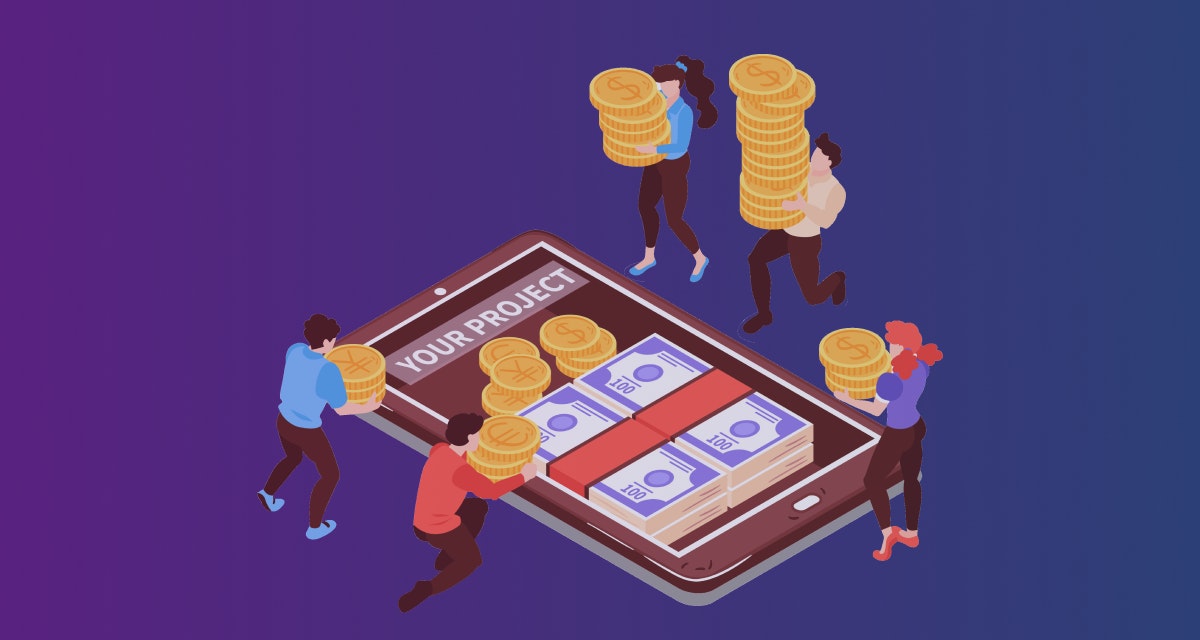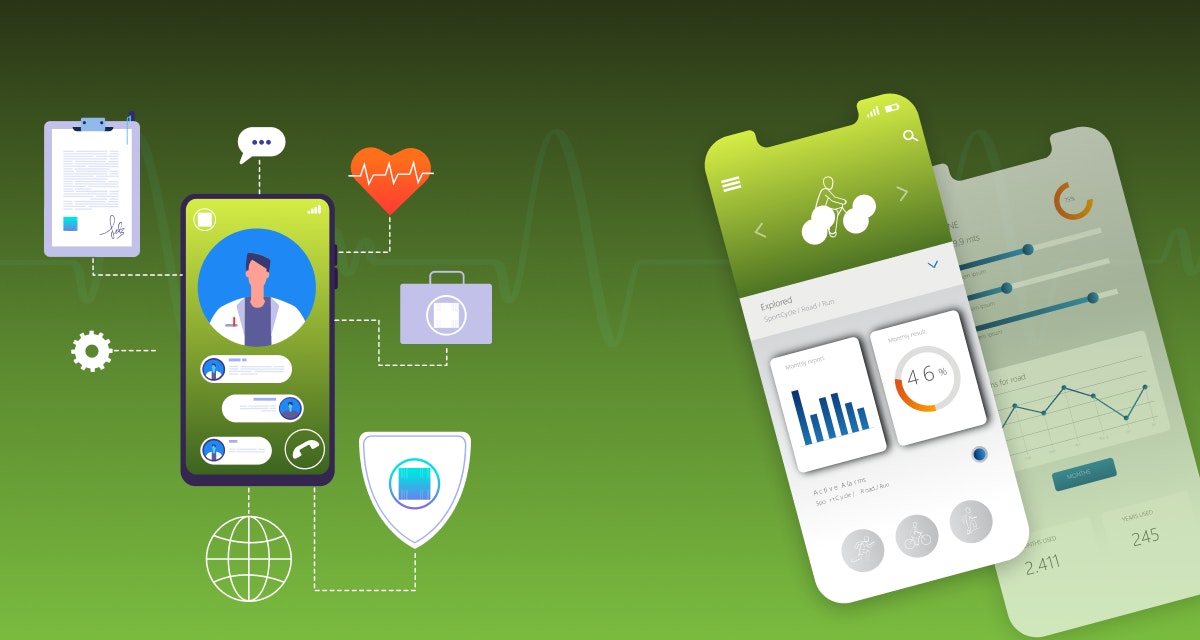Blockchain can make a massive difference to your decentralized food delivery app development—from improving supply chain and commission distribution to regulating restaurant participation and operations tracking.
Add custom functionalities like crypto wallets, different delivery modes, and optimized route detection, and you have an app as powerful as UberEats. Want to transform your cloud kitchen? You can through decentralized app development:
The food delivery market has witnessed commendable growth in the past five years, more so within the last 15 months due to the pandemic. In fact, the total US food delivery app revenue is projected to touch $42 billion by 2025. However, even though food delivery service has rescued many rumbling stomachs worldwide, it is not a new phenomenon.
Going back in time
The origin of ready-to-eat meals can be traced back to the Roman era in the 1800s. But the first food delivery was made in 1889 to King Umberto and Queen Margherita, starting a trend we relish to date.
Soldiers and workers have relied on meal delivery services for freshly prepared lunches. Technological advancement in the 1950s brought TV sets to a majority of American homes.
Families preferred staying in to watch their favorite shows and order food at home. But, then, it was the rise of fast food delivery and leisure meals. Taking the experience a step ahead, Pizza Hut launched Pizzanet in 1990, the first website for ordering food on the internet, followed by Waiter.com in 1995.
The comfort of quickly placing orders over the internet and eating at home made the service mainstream in no time. In 2011, mobile ordering through food delivery applications was started by Domino&rsquo's Pizza to offer a new level of convenience to customers.
Mobile apps for the win: 7 challenges resolved
The increasing popularity of smartphones and the ease of ordering through mobile applications made them a favorite among customers in no time. As a result, restaurant owners moved their menus onto these food delivery platforms to cater to customers interested in takeaway and home delivery.
Greater challenges were revealed as new business models of app-based food delivery evolved. There were issues like:
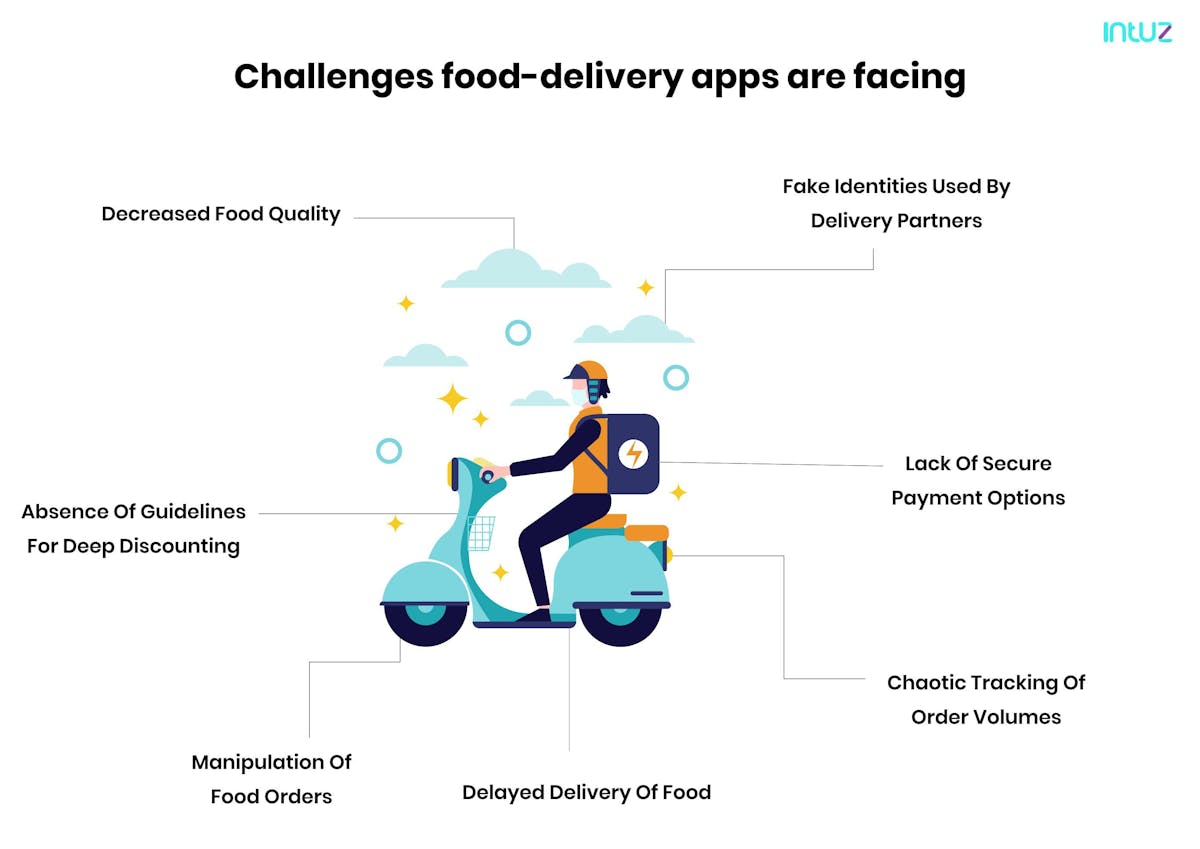
1. Decreased food quality
Maintaining food quality when delivering it to a customer’s doorstep is challenging. It is not the same as the food being served at the outlet. Using high-cost packaging to maintain temperature and retain freshness is also not a cost-effective option. Besides, the customer has no method to find out if the delivered food was prepared in hygienic conditions.
2. Absence of guidelines for deep discounting
Food delivery app owners or aggregators use deep discounting to lure customers to their platform. On the other hand, restaurants and food business owners have to bear losses owing to such heavy discounting strategies. There are no clear guidelines to control such scenarios, which leads to lower income for both parties.
3. Manipulation of food orders
Customers may intentionally or accidentally place incorrect orders. For example, technical glitches in mobile applications and delivery management systems may lead to changes in food items, quantity, or address. Such fake or erroneous orders lead to wastage of resources for both the restaurant and the aggregator.
4. Delayed delivery of food
Customer experience is ruined by late delivery of food. Therefore, accounting for external factors such as traffic, order volume, and weather conditions is necessary. Sometimes lack of training, shortage of staff, improper scheduling, and ineffective route planning can lead to a mismanaged delivery routine. It also consumes additional efforts of the customer support resources of the delivery platform to appease customers in such cases.
5. Chaotic tracking of order volumes
Keeping track of online demand and available resources becomes difficult for restaurant owners. As a result, they accept large volumes of orders and are often unable to fulfill them. This leads to delayed deliveries and deterioration in food quality.
6. Lack of secure payment options
Customers will not order through food delivery platforms that do not offer multiple modes of payment. They expect secure payment methods and a streamlined refund process.
7. Fake identities used by delivery partners
They are often found using fake identities on food delivery platforms. This is a major security violation and may even lead to regulatory issues. Delivery of food through unverified personnel also breaches customer trust on the food delivery platform.
Type of business models in food delivery services
Depending on multiple factors like budget, cuisine niche, delivery radius, and so on, those interested in offering food delivery services can choose a self-sustaining business model to optimize resources and boost the bottom lines. Here are the top three:
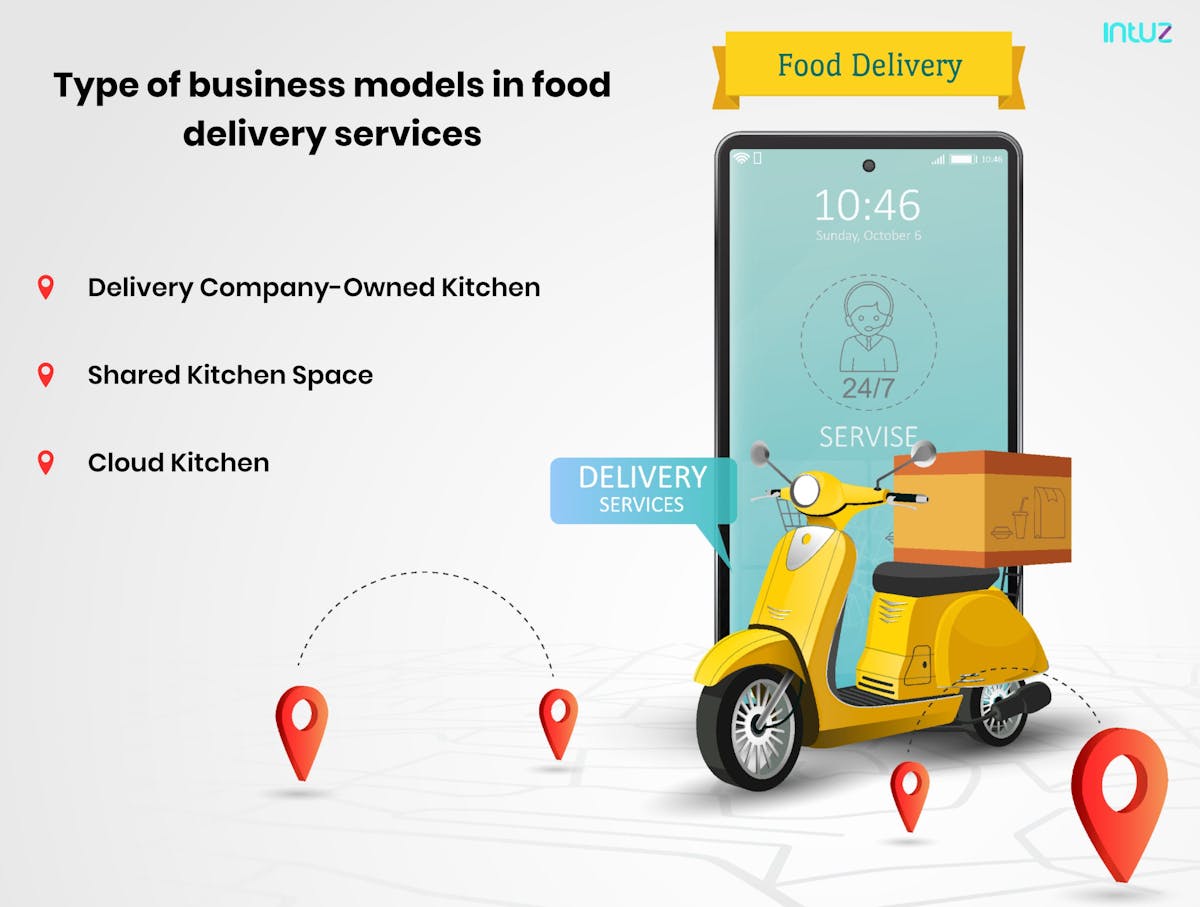
1. Delivery company-owned kitchen
These are bare kitchen spaces with gas pipelines, ventilation, and drainage only provided by the food delivery app company, and also go by the name “Shell.”
That means brands only have to manage the cooking process. Online order management and delivery services are handled by the aggregator or food delivery app owner. For example, Chicago’s Eat Purely cooks and delivers delicious meals with locally sourced products in the city.
2. Shared kitchen space
These are large commercial kitchens with infrastructure to support food production by multiple brands. Such licensed co-working spaces help bring down initial investment as rent is payable according to the number of hours or days of usage.
For example, Deliveroo’s Parisian shared space currently houses 12 kitchens in a warehouse in Saint-Ouen. Restaurants can either pay rent or start for free but later pay higher fees.
3. Cloud kitchen
These are licensed outlets for the commercial preparation of food. Such centralized facilities offer takeaway only as there is no space or facility for dine-in. Thus, they help meet the rising demand for food delivery while keeping business overheads minimal.
India-based Swiggy’s Cloud Kitchen has become even more popular during the pandemic. It recently launched “Marriott-on-wheels” with menus and pricing tailored for home deliveries.
Blockchain development is FREE to Learn!
Get Started With the GuideBenefits of using Blockchain in food delivery apps
In 2020 alone, the US food delivery revenue amounted to $26.5 billion. Some consumers have meals delivered even more often, with 8% ordering at least six times a week. This shows there is never a better time to foray into the world of open-source food delivery apps. But to gain a competitive edge, businesses must leverage technology like never before.
Blockchain can make a lot of difference
Simply put, it is a decentralized database that stores data in groups known as ‘blocks’ connected to the previous groups. Thus, it works as a distributed ledger technology offering an immutable and unchangeable record of all transactions. The security and transparency that Blockchain technology offers to make it efficient enough to regulate business operations. For example, the food industry supply chain comprises multiple participants, such as raw-material suppliers, kitchens, aggregators, delivery agents, and consumers.
Using Blockchain helps the industry to connect its functioning to develop a productive and trust-based ecosystem. Food delivery app developers and business owners can benefit from implementing Blockchain technology to secure their systems and streamline processes to boost revenue. The primary advantages of adopting Blockchain for on-demand food delivery apps are:
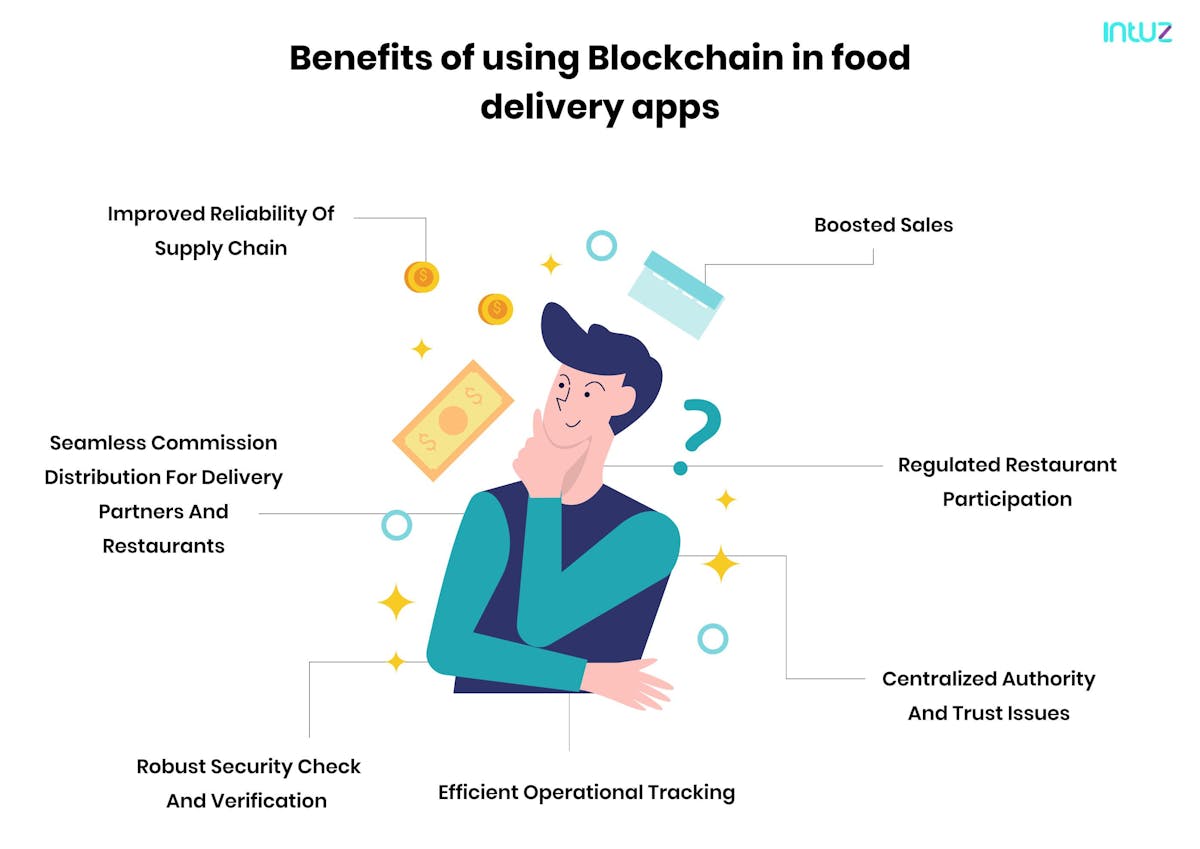
1. Improved reliability of supply chain
Blockchain can help you optimize your food delivery supply chain. Organize all activities such as procuring raw material, order management, meal preparation, packaging to delivery at the customer’s doorstep.
Set up a foolproof workflow reducing chances of error and miscommunication. Streamlining business processes using Blockchain improves efficiency throughout the supply chain. Optimizing operations at all levels helps save costs and time.
2. Seamless commission distribution for delivery partners and restaurants
Commission distribution and disbursement challenge traditional food delivery systems because of the multiple intermediaries between the involved parties. When the layers increase, it also inflates the commission rate to as high as 30%.
The multiple parties and intermediaries involved can be managed through Blockchain. It tracks all activities performed by delivery partners and restaurants. Any regulatory violations can be tracked before commission payouts reducing instances of delay in payments.
3. Robust security check and verification
Blockchain helps adhere to the strict security standards of the food industry. It also protects customer information and transactional data from fraud. Blockchain-based applications can also help ensure food safety by detecting contamination of food items.
4. Efficient operational tracking
Blockchain offers a high level of transparency, making tracking of each operation feasible by everyone in the supply chain. In addition, easy monitoring helps identify bottlenecks for process optimization. For instance, Zomato keeps track of the delivery personnel on their end, whereas the customer can do the same from the app.
5. Centralized authority and trust issues
In continuation to the above point, addressing trust issues among aggregators, restaurants, and customers becomes hassle-free because of a Blockchain-powered app. The decentralized Blockchain system offers transparency to all members of the ecosystem, i.e., restaurants, delivery partners, and the end consumer.
6. Regulated restaurant participation
Blockchain allows you to use smart contracts and automatically regulate restaurant participation. For instance, you can automate business processes to remove any restaurant or delivery partners who are not adhering to the law. Smart contracts ensure compliance with industry norms and auto disbursement of commission payments.
7. Boosted sales
Ease of ordering and tracking through Blockchain-integrated food apps improves customer experience and boosts sales. Aggregators and restaurants can also create loyalty programs to attract a more stable customer base to their platform and launch subscriptions.
Plus, it is easier for them to check the cash flow in the restaurant without having to manually check the spreadsheets or open the registers, figuratively speaking.
Building Blockchain-powered food delivery apps
Making a Blockchain-powered food delivery app requires integrating an attractive and engaging app UI with a Blockchain-based backend. The high-end application should be accessible through iOS and Android devices and even web browsers. Besides the basic food app functionality, it should offer the following features for effective performance:
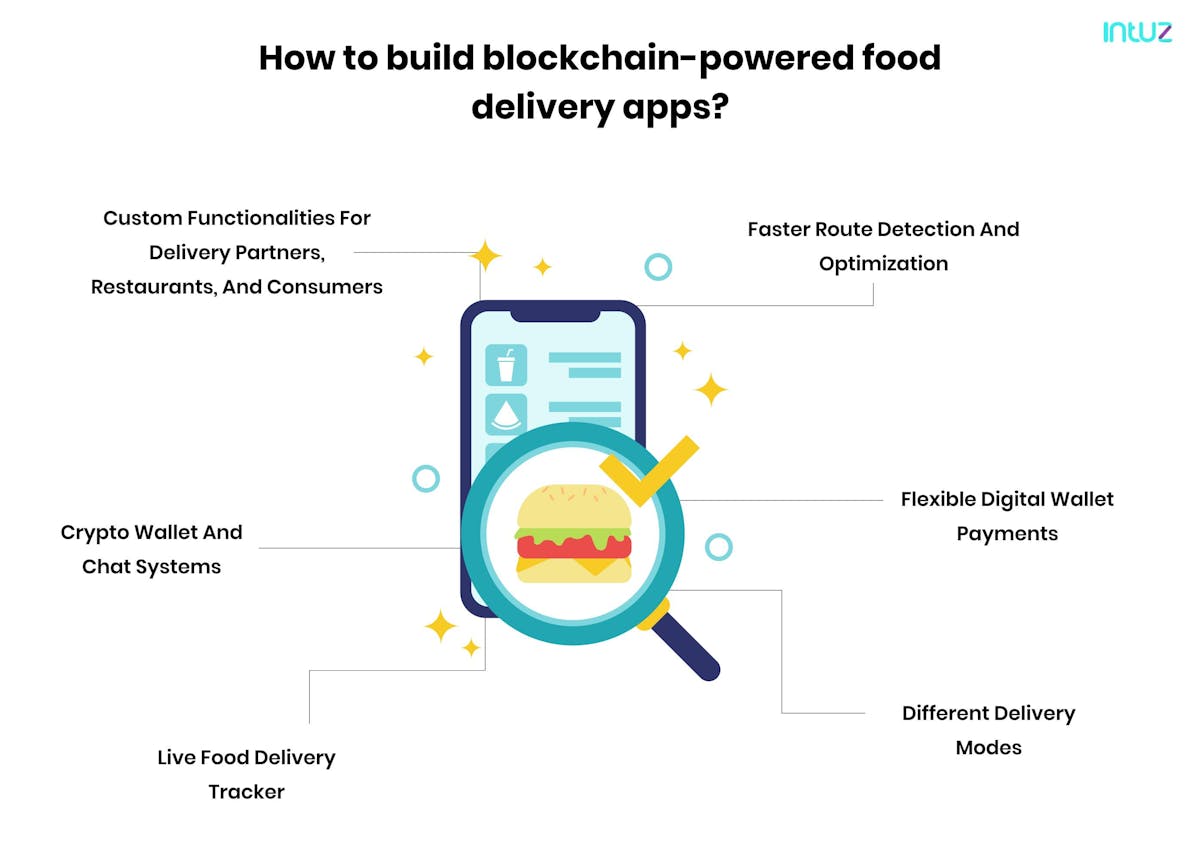
1. Custom functionalities for delivery partners, restaurants, and consumers
Cut down third-party involvement by offering custom features useful for all delivery partners, restaurants, and consumers. Design them to ensure you address their pain points from the existing systems and improve their use of the app.
2. Crypto wallet and chat systems
Leverage the rising popularity of digital money by including a cryptocurrency wallet in your Blockchain-powered food delivery app as a payment option. In addition, to offer immediate assistance and enhance customer experience, you can implement AI-driven chat systems.
Be on the beam of cryptocurrency exchange app!
Check out the full guide3. Live food delivery tracker
Being able to live track order makes the process transparent and enhances customer trust. Adding a live tracking feature throughout the food procurement and preparation chain to ensure the quality of food.
4. Different delivery modes
You can give your consumers and restaurant owners more power by offering delivery modes such as platform-to-consumer delivery, where brands like UberEats are responsible for both delivery and ordering process, and restaurant-to-consumer delivery where the restaurant itself takes orders and delivers. The ability to select their preference enhances customer satisfaction.
5. Flexible digital wallet payments
A dynamic digital payment wallet that accepts a wide variety of payment options is a must. Therefore, ensure the wallet is secure and supports payment from popular gateways such as Stripe, Google Pay, PayPal, and Braintree.
6. Faster route detection and optimization
Timely food delivery is crucial to maintain the taste and quality of food. Adding route selection and optimization features helps save costs and ensure timely delivery each time.
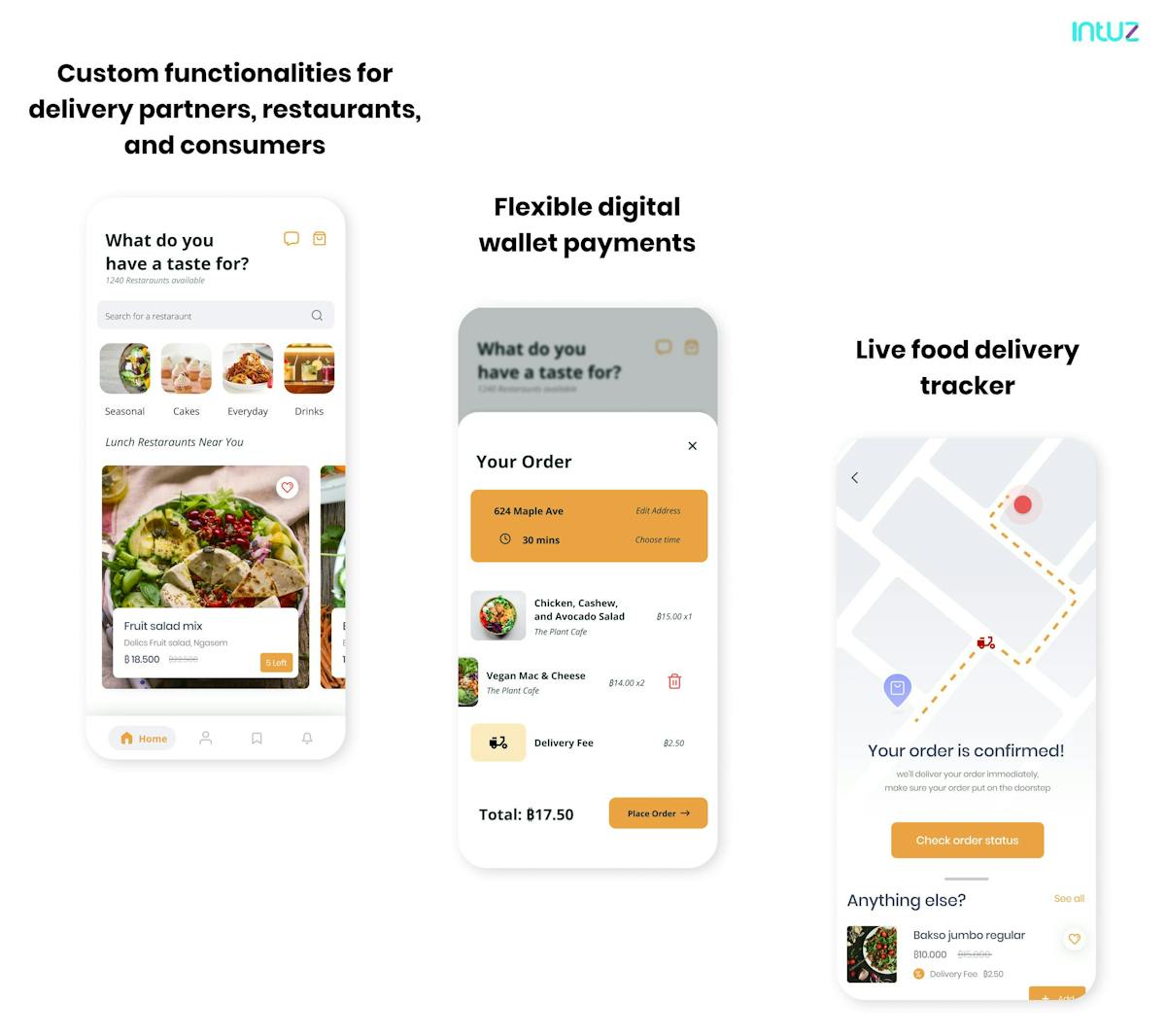
UberEats leads the way as the most widely available food delivery service
UberEats is the first Blockchain-based food delivery app that runs on Hyperledger Sawtooth Blockchain. It has stringent security measures and offers features such as delivery scheduling, live order tracking, and multiple payment modes for a hassle-free ordering experience.
Food business owners can leverage route optimization and historical data analytics to serve customers better in the Hyperledger app development process. Plus, the UberEats clone app offers new industry entrants a low-investment option to quickly build a similar feature-rich app.
The future of food delivery apps
The online food delivery market has grown exponentially during the COVID-19 pandemic. People adopted online ordering as governments across several nations announced a lockdown to curb the contagious virus spread.
Consumers prefer ordering food online as they have to manage the increased workload of household chores accompanied by the pressure of remote working.
Reports predict the market to depict a CAGR of 11% and reach $192.16 billion by 2025. Therefore, it is an excellent time for you to establish an on-demand food delivery business as the industry is flourishing and customers adapt to technological advancements.
In conclusion
Offering convenience, security, and timely delivery through a Blockchain-powered food delivery app will help your business grow. The best part is you can leverage the script of apps like UberEats to build an equally popular Blockchain-backed food ordering platform yourself!
If you need help, Team Intuz can help you achieve your goal. Call us at +1 650.451.1499 or fill the contact form so that we can get in touch with you to understand your requirements.
